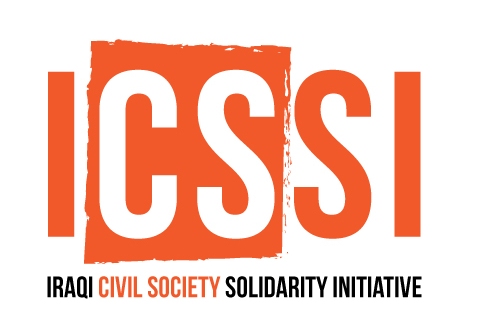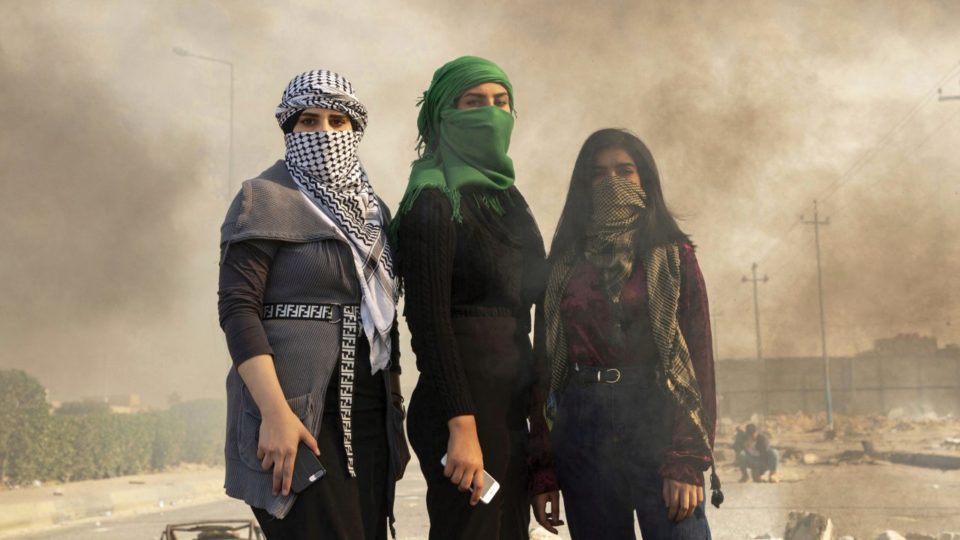The Young Iraqis Fighting for a Modern, Independent Nation
For decades the country has been brutalised by dictatorship, war, corruption and unemployment. Now Iraq’s young people are risking their lives again to bring about a political revolution
Tucked in my bag on my first visit to Baghdad in two years was a copy of Muhsin al-Ramli’s The President’s Garden, the brilliant modern epic of Iraqi suffering and totalitarianism. In 350 pages the name Saddam Hussein doesn’t appear once, but the dictator’s terror and insanity are made plain.
Iraq is burdened by Hussein’s legacy, as well as the Iran-Iraq War of the 1980s, the 2003 American-led invasion to topple Hussein and destroy the Ba’athist state, the civil war of 2014-17 and Islamic State’s (IS) reign of terror. But its young people have had enough. At the barricades, at the makeshift beach they’ve built on banks of the Tigris, and at the centre of the capital’s pulsing protest camp in Tahrir Square, I didn’t hear Saddam’s name mentioned once – this was a first in years of visiting Baghdad.
The protesters are done with the excuses of the recent past being used to deny them a future. The have taken to the streets in a stand against sectarianism, foreign influence, corruption and unemployment. Iraqi security forces have responded with lethal force, and more than 600 people have died since the protests began in October last year.
On Mohammed al-Qasim highway in central Baghdad, Karra Asad, 27, stood wearing an eye patch. He had an Iraqi flag draped over his shoulders. Little traffic passed by: the car tyres blazing behind him had brought the expressway to a standstill and the smoke from the burning rubber made his good eye weep.
We want a life like the life in Europe, America or other countries,” he told me. “We want politicians who are from the people, not politicians who are supported by Iran, Saudi, America or any other country, and we want politicians… who are the sons of this country.
His eye was injured in an earlier demonstration and he needs to go abroad for treatment, but there are few places where his passport will take him.
We will not stop, he said, “with the momentum of the young guys in Baghdad and other provinces until all demands are met.”
Around him the yellow tuk-tuks that have come to serve as logistics vehicles and ambulances for the protesters ferried people through the smoke, their sirens and horns blaring. The Federal Police, armed as they were when they fought IS, would fire tear gas and live rounds to break up the demonstration. The protesters were armed with a few Molotov cocktails, and sticks.
I met Nibras Hashim at her artists’ collective, housed in one of the many tents around Tahrir Square. She had a message similar to Karar Asad:
We wish other countries like the US and Iran would let the Iraqi youth to have their revolution with love and respect. We want Iraq to be a free country, like any other that has struggled for its freedom.
In Basra, Najaf and Nasiriyah, citizens continue to demand change. The US assassination of Qasem Soleimani – Iran’s leading general and regional Mr Fix-It – outside Baghdad airport on 3 January shook the country. But even then the protesters didn’t blink. The mercurial Shia cleric Muqtada al-Sadr, who had prevaricated over backing the protests, sent in his men, cracking skulls and killing young demonstrators. He said his supporters were there to root out infiltrators and foreign saboteurs, and he sounded like an Arab dictator of old. But in Najaf the kids were back on the streets the next day.
Iraq is a young country – some 60 per cent of its population is under 25 years old – and despite its oil wealth, it is still a wreck. In Baghdad new steel skyscrapers are rising as bank headquarters, but the streets below are crumbling. The hopes of Iraq’s protesters may sound like another false spring in the Arab world, and certainly the odds are stacked against them, but this grass-roots movement – the young men and women prefer to call it a revolution – is different.
“It’s the most profound social movement the country has seen since its founding in 1958,” one veteran Iraqi politician told me. The young men and women on the streets are from all social classes and religious sects; Iraq’s disfunction has united them.
They have achieved some success: they toppled the government of the previous prime minister, Adil Abdul-Mahdi, and have brought about a new electoral commission and voting laws. But the political and religious oligarchy won’t go easily. The protesters want fresh elections, but one Western diplomat told me that, even with the new election law, the old parties are feeling comfortable.
Iraq is a country with a personality disorder and almost no self-control. In the past year, its territory has been bombed by Israel, Turkey, Iran and the US. The nation is in a permanent state of outrage over its sovereignty being violated, but never more so than with the killing of Soleimani and Abu Mahdi al-Muhandis, the head of the Iranian-backed militia, outside Baghdad airport last month. Internally, the government has a loose grip. Shia militia, who helped defeat IS, are terrorising the protesters.
One afternoon I went to the US embassy, where they were still cleaning the scorch marks and graffiti from an assault by an Iranian-backed Shia militia. A Chinook helicopter was waiting to fly us to al-Asad airbase in Anbar province. The site was the target a week earlier, on 8 January, of an Iranian missile barrage – Tehran’s full-frontal response to Soleimani’s death.
For me, it was a return to a base that stands as a barometer of US interest in Iraq. George W Bush visited in 2007, when the US occupation was at its height. The first time I went, in December 2014, the US was long gone and IS was almost at the gates.
Half a dozen men armed with sticks could overwhelm the base, a chain-smoking Iraqi commander told me at the time.
The Iraqi wounded were lined up on the runway as we left. Iraq was losing the war against IS. It seems like a long time ago.
Islamic State brought the US back to al-Asad, and Iraq. The official number of American troops in the country is now around 5,000, but the real figure is likely double that. The mission against IS, in which Britain still plays a part, is now in question, following the killing of Soleimani.
US airbases exist in a vacuum, mostly untouched by the countries around them. Still, it is unusual for the US with all its might to be attacked so directly by another country. “When did it last happen – Pearl Harbor?” laughed one Iraqi politician I spoke to.
At al-Asad cappuccino and pizza are available, but the dining facility wasn’t in full use for fear of another attack. Large craters by the airstrip where Air Force One has landed more than once (President Trump visited on 26 December 2018) were testament to the force of the recent missile attack. The Iranians had come close to hitting the spot where predator drones are kept, perhaps in the (probably mistaken) belief that the drone that assassinated Soleimani was launched from al-Asad.
When the first strikes occurred, we were able to see them as they came in, said Lieutenant Colonel Antoinette Chase
The US had plenty of warning: most of the base personnel were in bunkers and no one was killed, although more than 100 are reported to have suffered concussion.
But the Western mission in Iraq is now in question. Iraq’s parliament, minus Sunni and Kurdish politicians, voted to end the presence of US and foreign troops in Iraq after the killing of Soleimani. However, a compromise is being planned. In Baghdad, arrangements are being made for Western military involvement to be rebranded as a Nato-led operation.
The mission needed to change in any case. IS has lost all its territory, the Iraqis are in a much better position, said one sanguine senior coalition commander.
I visited two Iraqi commanders, old friends from the battles in Mosul; one American-trained, the other Iranian-trained. They fought bravely against IS and both lost many men. Unsurprisingly, they disagreed on whether it was time for the US and others to leave. Our conversations turned to the young protesters and on that subject alone, they were in agreement.
They will win, they both said.
Perhaps even hardened military men are guilty of wishful thinking – much stands in the way of the protesters achieving success. But the resilience of Iraqis is none the less remarkable. As well as the dead, thousands have been injured and hundreds detained.
On al-Sinak bridge over the Tigris they have built a front line, with Iraqi security forces at the opposite end, protecting Baghdad’s Green Zone. From there you could hear the music from the beach the protesters had built with trucked-in sand. Three young men were killed the night before I met Hamza Ali Muhammad, 17. He has no job and had been on the bridge for months.
Iraq is a dangerous place to have hope. Three times Ali Muhammad has escaped kidnap. Then came a letter: inside was a bullet. “They said to me, ‘Be a good boy.’ I didn’t care, I came back,” he said.
That evening I drove past Firdos Square, where Saddam Hussein’s statue was toppled in 2003. On my last visit it was still a ruin, but the base remained like the root of diseased tree. The square is being refurbished and the pedestal is now gone. In nearby Tahrir Square, the tents were full and illuminated, as the country’s young readied for the next day’s protests and plotted Iraq’s escape from the past.




